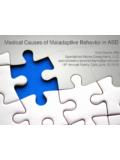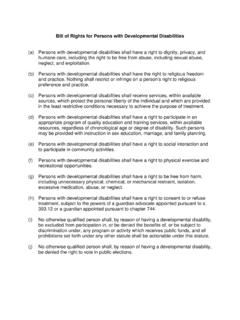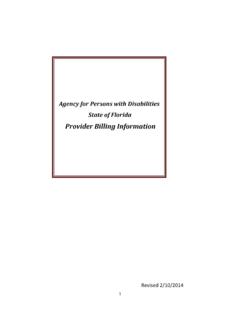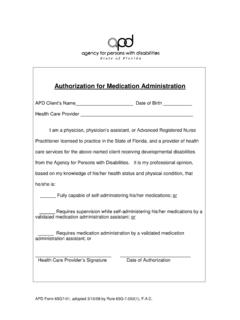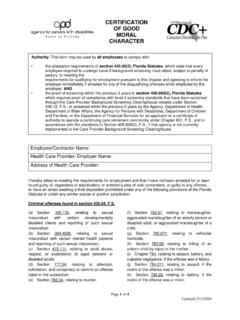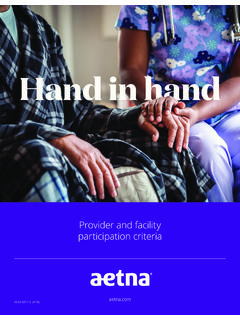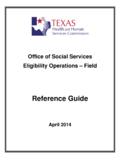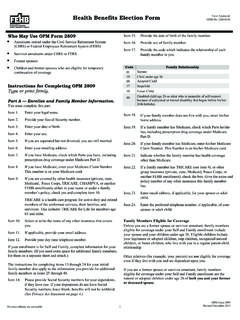Transcription of Florida Medicaid - APD
1 DEVELOPMENTAL DISABILITIES INDIVIDUAL BUDGETING WAIVER services COVERAGE AND LIMITATIONS HANDBOOK Agency for Health Care Administration September 2015 Florida Medicaid DEVELOPMENTAL DISABILITIES INDIVIDUAL BUDGETING WAIVER services COVERAGE AND LIMITATIONS HANDBOOK UPDATE LOG How to Use the Update Log Introduction The update log provides a history of the handbook updates. Each Florida Medicaid handbook contains an update log. Obtaining the Handbook Update When a handbook is updated, the Medicaid provider will be notified. The notification instructs the provider to obtain the updated handbook from the Medicaid fiscal agent s Web site at Explanation of the Update Log Providers can use the update log below to determine if updates to the handbook have been received. Update describes the change that was made. Effective Date is the date that the update is effective. UPDATE EFFECTIVE DATE New Handbook September 2015 DEVELOPMENTAL DISABILITIES INDIVIDUAL BUDGETING WAIVER services COVERAGE AND LIMITATIONS HANDBOOK TABLE OF CONTENTS Chapter and Topic Page Introduction to the Handbook Overview.
2 I Handbook Use .. ii Characteristics of the Handbook .. iii Handbook Updates .. iv Chapter 1 Qualifications and Enrollment Overview .. 1-1 Purpose .. 1-1 Definitions .. 1-2 Qualifications .. 1-11 Enrollment .. 1-26 Chapter 2 Covered, Limited, and Excluded services Overview .. 2-1 General Information .. 2-2 Life Skills Development Level 1 Companion .. 2-14 Life Skills Development Level 2 Supported Employment .. 2-15 Life Skills Development Level 3 Adult Day Training .. 2-21 Consumable Medical Supplies .. 2-25 Durable Medical Equipment and Supplies .. 2-29 Environmental Accessibility Adaptations .. 2-36 Personal Emergency Response System .. 2-39 Personal Supports .. 2-40 Respite Care .. 2-43 Residential Habilitation General Information .. 2-45 Residential Habilitation (Standard) .. 2-47 Residential Habilitation (Behavior Focused) .. 2-50 Residential Habilitation (Intensive Behavior) .. 2-54 Special Medical Home Care .. 2-60 Supported Living Coaching .. 2-61 Support Coordination.
3 2-66 Behavior Analysis services .. 2-91 Behavior Assistant services .. 2-94 Dietitian services .. 2-96 Private Duty Nursing .. 2-97 Residential Nursing services .. 2-98 Skilled Nursing .. 2-99 Occupational Therapy .. 2-100 Physical Therapy .. 2-101 Respiratory Therapy .. 2-102 Speech Therapy .. 2-102 Specialized Mental Health Counseling .. 2-103 Transportation services .. 2-104 Dental 2-106 Chapter 3 Reimbursement and Fee Schedule Overview .. 3-1 Reimbursement Information .. 3-1 Service Authorization .. 3-4 Appendices Appendix A: Billing and Documentation Requirements .. A-1 Appendix B: iBudget Training Requirements for iBudget Waiver Providers .. B-1 Appendix C: Service Specific Training Requirements .. C-1 Appendix D: Regional Offices for the Agency for Persons with Disabilities .. D-1 Appendix E: Medicaid Waiver services Agreement .. E-1 Appendix F: Incident Reporting Form .. F-1 Appendix G: Functional Community Assessment Form .. G-1 Appendix H: Housing Survey Form.
4 H-1 Appendix I: Financial Profile .. I-1 Appendix J: Qualifications for Trainers/Trainer Agreement Form .. J-1 Developmental Disabilities Individual Budgeting Waiver services Coverage and Limitations Handbook INTRODUCTION TO THE HANDBOOK Overview Introduction This chapter outlines the three types of Florida Medicaid policy handbooks that all enrolled providers must comply with in order to obtain reimbursement. This chapter also describes the format used for the handbooks and instructs the reader how to use the handbooks. Background There are three types of Florida Medicaid handbooks: Provider General Handbook describes the Florida Medicaid program. Coverage and limitations handbooks explain covered services , their limits, who is eligible to receive them, and any corresponding fee schedules. Fee schedules can be incorporated within the handbook or separately. Reimbursement handbooks describe how to complete and file claims for reimbursement from Medicaid .
5 The current Florida Medicaid provider handbooks are posted on the Medicaid fiscal agent s Web site at Federal and State Authority The following federal and state laws govern Florida Medicaid : Title XIX of the Social Security Act Title 42 of the Code of Federal Regulations Chapter 409, Florida Statutes Rule Division 59G, Florida Administrative Code In This Chapter This chapter contains: TOPIC PAGE Overview i Handbook Use ii Characteristics of the Handbook iii Handbook Updates iv September 2015 i Developmental Disabilities Individual Budgeting Waiver services Coverage and Limitations Handbook Handbook Use Purpose The purpose of the Medicaid handbooks is to educate the Medicaid provider about policies and procedures needed to receive reimbursement for covered services provided to eligible Florida Medicaid recipients. The handbooks provide descriptions and instructions on how and when to complete forms, letters, or other documentation.
6 Provider Term used to describe any entity, facility, person, or group who is enrolled in the Medicaid program and provides services to Medicaid recipients and bills Medicaid for services . Recipient Term used to describe an individual enrolled in Florida Medicaid to receive service. Provider General Handbook Information that applies to all providers regarding the Florida Medicaid program, recipient eligibility, provider enrollment, fraud and abuse policy, and important resources are included in the Florida Medicaid Provider General Handbook. Coverage and Limitations Handbook Each coverage and limitations handbook is named for the service it describes. A provider who renders more than one type of Medicaid service will have more than one coverage and limitations handbook with which they must comply. Reimbursement Handbook Most reimbursement handbooks are named for the type of claim form submitted. September 2015 ii Developmental Disabilities Individual Budgeting Waiver services Coverage and Limitations Handbook Characteristics of the Handbook Format The format of the handbook represents a reader-friendly way of displaying material.
7 Label Labels are located in the left margin of each information block. They identify the content of the block in order to help scanning and locating information quickly. Information Block Information blocks replace the traditional paragraph and may consist of one or more paragraphs about a portion of the subject. Blocks are separated by horizontal lines. Each block is identified or named with a label. Chapter Topics Each chapter contains a list of topics on the first page, which serves as a table of contents for the chapter, listing the subjects and the page number where the subject can be found. Note Note is used to refer the reader to other important documents or policies contained outside of this handbook. Page Numbers Pages are numbered consecutively within each chapter throughout the handbook. The chapter number appears as the first digit before the page number at the bottom of each page. White Space The "white space" found throughout a handbook enhances readability and allows space for writing notes.
8 September 2015 iii Developmental Disabilities Individual Budgeting Waiver services Coverage and Limitations Handbook Handbook Updates Update Log The first page of each handbook will contain the update log. Every update will contain a new updated log page with the most recent update information added to the log. The provider can use the update log to determine if all updates to the current handbook have been received. Each update will be designated by an Update and Effective Date. Handbook Update Classifications The Medicaid handbooks will be updated as needed. Updates are classified as either a: Replacement Handbook Major revisions resulting in a rewrite of the existing handbook, without any underlines and strikethroughs throughout the rulemaking process. Revised Handbook Minor revisions resulting in modification of the existing handbook identified during the rulemaking process by underlines and strikethroughs. Handbook Effective Date The effective date of a handbook is the month and year that will appear on the final published handbook.
9 The provider can check this date to ensure that the material being used is the most current and up to date. Identifying New Information New information or information moved from one place to another within the handbook will be identified by an underline on draft versions of the handbook during the development and proposed stages of the rulemaking process ( , new information). Identifying Deleted Information Deleted information will be identified by a line through the middle of the selected text on draft versions of the handbook during the development and proposed stages of the rulemaking process ( , deleted information). Final Published Handbook The adopted and published version of the handbook will not have underlines (indicating insertions) and text with strikethroughs (indicating deletions). September 2015 iv Developmental Disabilities Individual Budgeting Waiver services Coverage and Limitations Handbook CHAPTER 1 QUALIFICATIONS AND ENROLLMENT Overview Introduction This chapter describes Florida Medicaid s Developmental Disabilities Individual Budgeting (iBudget) Waiver services , the specific authority regulating these services , and provider qualifications and enrollment.
10 Legal Authority Home and community-based services (HCBS) waivers are authorized under section 1915(c) of the Social Security Act and governed by Title 42, Code of Federal Regulations (CFR), Parts 440 and 441. Section , Florida Statutes ( ), and Rule , Florida Administrative Code ( ), authorize the application for the Florida Medicaid Developmental Disabilities Individual Budgeting Waiver. The iBudget Waiver is referenced in Chapter 393, , and the Agency for Person s with Disabilities Rule , In This Chapter This chapter contains: TOPIC PAGE Overview 1-1 Purpose 1-1 Definitions 1-2 Qualifications 1-11 Enrollment 1-26 Purpose Introduction The iBudget Waiver provides home and community-based supports and services to eligible persons with developmental disabilities living at home or in a home-like setting. The iBudget Waiver program is funded by both federal and matching state dollars. Individuals enrolled in the iBudget Waiver should receive services that enable them to: Have a safe place to live.



